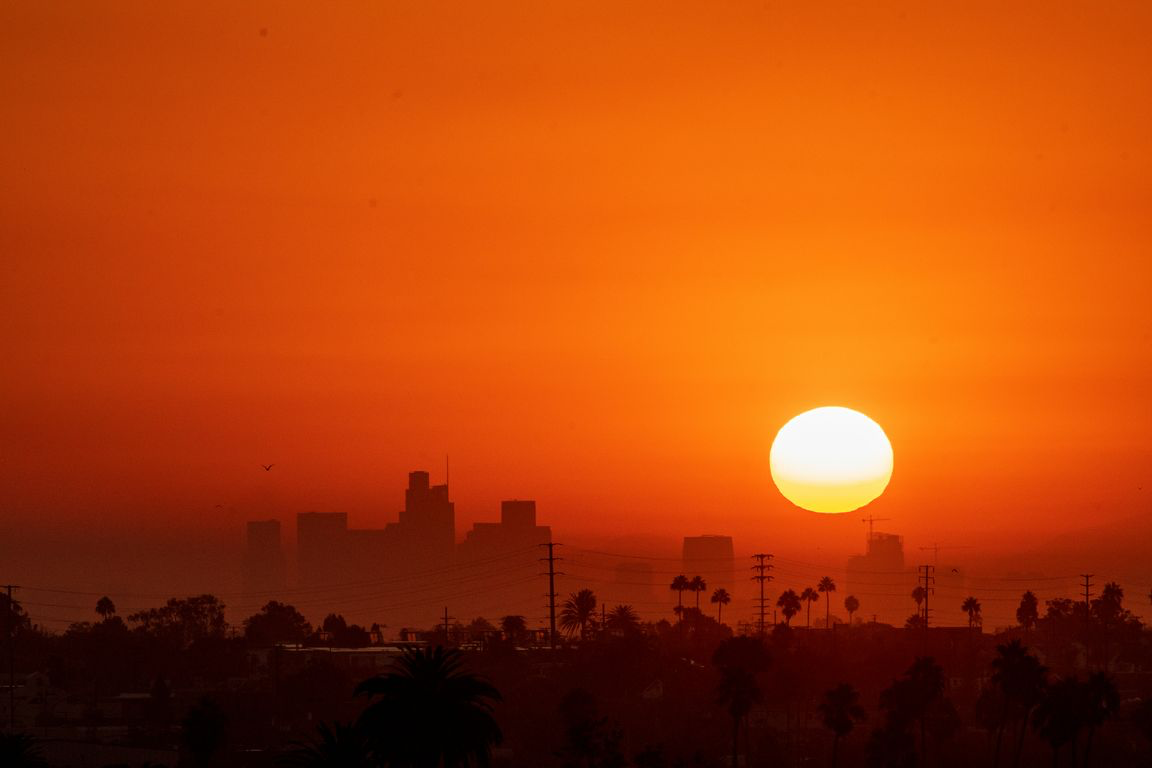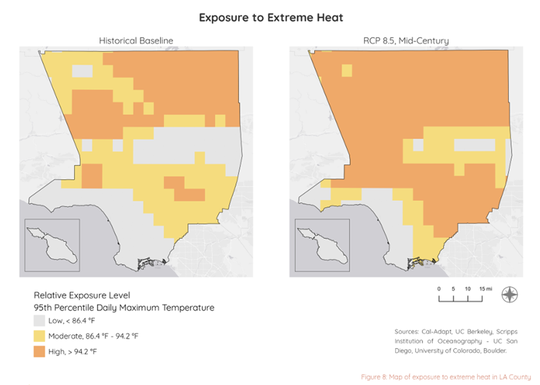
Hotter Days Ahead? We’ll Be Ready For That.
Hotter Days Ahead? We’ll Be Ready For That.
Our new Heat Action toolkit can help cities keep their cool
Greater L.A. has long been famous for its tank-top weather - but climate change means there will be more “Is the sidewalk-melting?” scorchers each year. And they come with a heavy cost. Los Angeles can expect as many as 3.3 times more heat-related deaths per year due to extreme heat by 2050, compared to 2020, according to one study. A 2006 heatwave in California resulted in 16,000 emergency-room visits and 650 deaths, costing $5.3 billion in lost productivity.
In response, the Chief Sustainability Office is developing a County Heat Action Plan (CHAP) to help our neighborhoods, infrastructure and ecosystems keep their cool. It’s about more than just coping with heatwaves: It’s a chance to reimagine our communities as healthier and more vibrant and connected places. Here’s a look at what’s in store.
Why is extreme heat such a growing concern in L.A. County — and who’s most affected?
The science is clear: L.A. is getting hotter. Climate change is driving up average temperatures and making heatwaves more frequent, longer, and intense. Average maximum temperatures are expected to rise in our region by five degrees by mid-century and as much as eight degrees by late century. Unlike floods or wildfires, heat can be invisible and easy to underestimate. It quietly worsens existing health conditions, impairs productivity and learning, and leads to a variety of injuries and illnesses.
Even without reaching the most dangerous levels of heat, higher average temperatures put strain on people and reduce the amount of time we can safely spend in the sun. What’s more, it hits hardest in neighborhoods with lower incomes, less tree cover, more asphalt, fewer parks and other public spaces. Due to a history of redlining and underinvestment, many communities of color are hotter than leafier parts of the County. This pattern shows up clearly in the County’s Climate Vulnerability Assessment, which highlights the communities most at risk from extreme heat and other climate threats. Our CHAP is built around equity for this very reason. We’re not just asking who’s feeling the heat— we’re working to ensure everyone is able to stay safe from the heat.

What exactly is a County Heat Action Plan?
Think of it as L.A. County’s blueprint for beating the heat — without just cranking up the A.C. and calling it a day. It’s a policy roadmap to ensure that communities and ecosystems can thrive in the face of rising temperatures. Measures include long-term investments in shade, cooling infrastructure, building upgrades and emergency preparedness. And the County won’t be doing this alone. The blueprint serves as a call-to-action for cities, businesses and communities to join us. It’s structured around three big goals:
- Cool and protect outdoor spaces – with more shade and vegetation, less pavement and smarter design.
- Make buildings more heat-resilient – through passive and efficient cooling and access to clean and reliable energy.
- Strengthen emergency response and heat safety communications – especially for vulnerable populations who may be isolated or unhoused.
Across all of these goals, equity is a guiding principle. The plan focuses on supporting places and populations that are most at risk and least resourced to cope with heat.
What does heat resilience look like at the street level – in terms of private residences, public spaces, schools and local businesses?
It looks like a welcoming outdoor environment: an abundance of vegetation, shade and cool spaces to for people to duck into, no matter their income, housing status or daily routine.
At home, it would mean cool roofs, better ventilation, and other efficient features that lower temperatures without spiking the energy bill. It also means making sure that everyone —whether they rent or own — has options for keeping their space safe and livable during extreme heat. At schools, it can look like living schoolyards and joint-use green spaces that are available for community use during non-school hours. And for local businesses, it might be incentives and streamlined permits for awnings, parklets and shade infrastructure — so people can shop, eat, and work without getting heatstroke. In other words, heat resilience doesn’t rely on one silver bullet. It’s a neighborhood-wide transformation, from home to bus stop, that makes life better along the way.
What are some of the specific programs we can put in place to make sure that residents can live more comfortably, that businesses can run safely, that children can be educated in a cooler setting?
We’re in the planning phase and exploring a wide range of programs designed to make heat resilience real at the local level. We want to support the changes communities have wanted for a long time. Some of the ideas on the table include:
- Increasing shade and hydration infrastructure in parks, transit hubs and other public spaces
- Support for HVAC upgrades in schools, senior housing and other sensitive buildings
- Testing out mobile cooling strategies and pop-up shade options for outdoor workers and unhoused residents
We’re also identifying policy changes — like streamlined permitting, new design templates, and potential incentives — that would help cities and local organizations bring these ideas to life more easily.
How do we reconcile the need for increased cooling in homes and businesses – which typically involves increased energy use – with the need to reduce our carbon footprint? It’s more than just mandating more energy-intensive air conditioning, right?
It a complex question that we’re taking seriously. The answer isn’t “no AC for anyone.” It’s smarter, cleaner cooling, paired with passive design strategies and energy system upgrades.
We’re focusing on ideas like:
- Passive cooling features like reflective roofs and ventilated building design
- Energy-efficient HVAC systems in buildings that really need them
- Solar + storage combos in community spaces so people stay cool even during outages
We’re not choosing between staying cool and cutting carbon. We’re doing both. Because solving one problem shouldn’t make the other worse.
Rising heat will also affect our local ecosystems and wildlife populations. Are we building in protections for the natural environment?
Great question — because plants and animals can’t exactly call 211 for help. Heat resilience isn’t just for humans. It’s for every living thing that calls L.A. home.
Heat stresses natural resources that L.A. County residents benefit from, such as street trees and unique ecosystems. That’s why our solutions should optimize co-benefits for the environment, such as improving green connectivity. We’re looking to expand urban greening in ways that support pollinators, native vegetation and stormwater infiltration. When we cool a neighborhood, we’re also boosting biodiversity, reducing flooding and building resilience for our whole environment. For example, the County’s Community Forest Management Plan is aimed at expanding and caring for our community forest to cool neighborhoods and support local ecosystems – and the CHAP will highlight some opportunities to accelerate its implementation.
What’s in this plan for cities, businesses and community groups?
A lot. We’ve heard loud and clear that communities know what they need. They just face barriers to making it happen. So we’re exploring how to remove roadblocks to cooling improvements (like permitting and zoning hurdles), and looking to develop resources such as model designs. Our plan is structured to help local governments and organizations get the green light to act – and the funding to make it happen.
How can community organizations and cities get involved?
Start with our Public Engagement Toolkit for Heat Action Planning. It’s packed full of materials — slides, activities, discussion guides — that help communities develop solutions that reflect local priorities.
How can vulnerable communities and stakeholder groups access and use the Public Engagement Toolkit?
Find the toolkit here: It’s designed to be flexible and adaptable to the unique contexts of different stakeholder and community groups, and includes guidance for tailoring the materials with locally-specific information. It's organized into four phases to support users at any stage of the heat action planning process. There are many resources for finding grants and other funding to make resilience a reality.
How does the Public Engagement Toolkit fit into the wider County Heat Action Plan Process?
While the CHAP lays out goals and steps for action, its implementation will ultimately take shape through the efforts of local partners who help bring community priorities to the forefront. We would love to hear about your community's priorities, and how you may use the toolkit; we encourage toolkit users to offer feedback via this form on the toolkit webpage.
What are next steps/timetable for implementing the Plan?
We’re working with potential implementation partners now to develop strategies and identify potential commitments, and we’ll put a draft plan out for public comment this fall. The final plan will come out toward the end of 2025. But many actions are already underway.
Anything else to share?
While the CHAP is rooted in science and policy, at its heart it’s about dignity. Everyone deserves to be safe in their home, on their block, at school or work -- no matter the weather. We’re building a County where kids can still play outside during the summer, and nobody has to choose between their health and their electric bill.